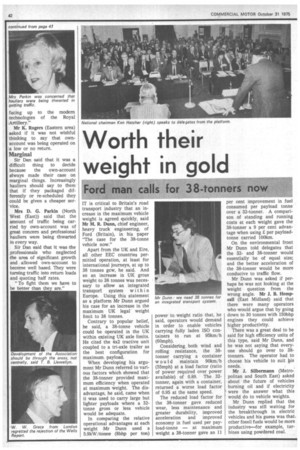Worth their weight in gold
Page 44

If you've noticed an error in this article please click here to report it so we can fix it.
IT is critical to Britain's road transport industry that an increase in the maximum vehicle weight is agreed quickly, said Mr M. R. Dunn, chief engineer, heavy truck engineering, of Ford (Britain), in his paper "The case for the 38-tonne vehicle now."
Apart from the UK and Eire, all other EEC countries permitted operation, at least for international journeys, at up to 38 tonnes gcw, he said. And so an increase in UK gross weight to 38 tonnes was necessary to allow an integrated transport system within Europe. Using this statement as a platform Mr Dunn argued his case for an increase in the maximum UK legal weight limit to 38 tonnes.
Contrary to popular belief, he said, a 38-tonne vehicle could be operated in the UK within existing UK axle limits. He cited •the 4x2 tractive unit coupled to a tri-axle trailer as the best configuration for maximum. payload.
When developing his argument Mr Dunn referred to various factors which showed that the 38-tonner provided maximum efficiency when operated at maximum weight. The disadvantage, he said, came when it was used to carry large but lighter payloads where a 32tonne gross or less vehicle would be adequate.
In comparing the relative operational advantages at each weight ,Mr Dunn used a 5.9kW/torine (8bhp per ton) power to weight ratio that, he said, operators would demand in order to enable vehicles carrying fully laden ISO containers to run at 95km/h (60mph).
Considering both wind and rolling resistance, the 38tonner carrying a container would maintain 90km/h (55mph) at a load factor (ratio of power required over power available) of 0.89. The 32tonner, again with a container, returned a worse load factor of 0.95 at the same speed.
The reduced load factor for the 38-tanner gave reduced wear, less maintenance and greater durability, improved acceleration and improved economy in fuel used per payload-tonne — at maximum weight a 38-tormer gave an 11 per cent improvement in fuel consumed per payload tonne over a 32-tonner. A comparison of standing and running costs at each weight gave the 38-tonner a 9 per cent advantage when using £ per payloadtonne carried 100km.
On the environmental front • Mr Dunn told delegates that the 32and 38-tanner would essentially be of equal size; and the better acceleration of the 38-tonner would be more conducive to traffic flow.
Mr Dunn was asked if perhaps he was not looking at the weight question from the wrong angle. Mr J. B. Hempsail (East Midland) said that there were many operators who would argue that by going down to 30 tonnes with 150bhp engines they could achieve higher productivity.
There was a great deal to be said for high efficiency units of this type, said Mr Dunn, and he was not saying that everyone should go over to 38tanners. The operator had to choose his vehicle to suit his needs.
Mr J. Silbermann (Metropolitan and South East) asked about the future of vehicles burning oil and if electricity were the answer what this would do to vehicle weights.
Mr Dunn replied that the, industry was st11 waiting for the breakthrough in electric vehicles and his guess was that. other fossil fuels would be more productive—for example, turbines using powdered coal.
































































































